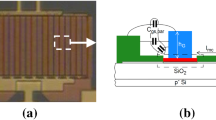Abstract
A method for designing carbon nanotube field-effect transistors (CNTFETs) with optimized oxide thickness is proposed herein. The optimum oxide thickness that provides the maximum current ratio (on/off ratio) is calculated for each design. The effect of oxide thickness on the on/off ratio is investigated by treating it as the independent variable and calculating the on-state and off-state currents. Particle swarm optimization is used to determine the exact optimum oxide thickness to achieve the maximum current ratio, which is one of the most important parameters in switching applications. The optimum insulator thickness is calculated for CNTFETs with different chiral vectors, insulator types, channel lengths and source/drain do** levels. For further study of the CNTFETs, performance parameters including cutoff frequency and transconductance of the devices are also calculated and investigated. The results show that CNTFET designers should select the oxide thickness very carefully, not simply based on reported values in other works. Each design requires its own optimum oxide thickness which provides the maximum on/off current ratio only for that design.









Similar content being viewed by others
Availability of data and material
All data that support the figures and tables of this study are available on request.
References
Chen, Z.: Nanotubes for nanoelectronics. Encycl. Nanosci. Nanotechnol. 7, 919–942 (2004)
Smalley, R. E.: Available: http://www.ruf.rice.edu/∼smalleyg/imagegallery.html (2002)
Khademhosseini, V., Dideban, D., Ahmadi, M., Ismail, R.: Impact of chiral indices on the performance of single electron transistor utilizing carbon nanotube island. ECS J. Solid State Sci. Technol. 8(3), 26–29 (2019)
Saito, R., Dresselhaus, M.S., Dresselhaus, G.: Physical Properties of Carbon Nanotubes. World Scientific, Singapore (1998)
Tanaka, K., Yamabe, T., Fukui, K.: The Science and Technology of Carbon Nanotubes. Elsevier, Amsterdam (1999)
Raeini, A.G.N., Kordrostami, Z.: Modified Schottky barrier CNTFET with lightly doped drain. IET Micro Nano Lett. 13, 1–5 (2018)
Pradhan, K.P., Sahu, K.P.: Benefits of asymmetric underlap dual-k spacer hybrid fin field-effect transistor over bulk fin field-effect transistor. IET Circuits Devices Syst. 10, 441–447 (2016)
Wang, W., Wang, H.: Performance analysis of an ultralow power circuit using single halo CNTFETs. IOP Semicond. Sci. Technol. 30, 1–9 (2015)
Zoheir Kordrostami, M.: Hossein Sheikhi, and Abbas Zarifkar, “Influence of Channel and Underlap Engineering on the High-Frequency and Switching Performance of CNTFETs.” IEEE Trans. Nanotechnol. 11, 526–533 (2012)
Owlia, H., Keshavarzi, P.: Locally defect-engineered graphene nanoribbon field-effect transistor. IEEE Trans. Electr. Devices 63, 3769–3775 (2016)
Shirazi, S.G., Mirzakuchaki, S.: High on/off current ratio in ballistic CNTFETs based on tuning the gate insulator parameters for different ambient temperatures. Appl. Phys. A 113(2), 447–457 (2013)
Raeini, A.G.N., Kordrostami, Z., Javaheri, M.: High on/off current ratio in SB-CNTFET based on tuning the gate insulator parameters for different ambient temperatures, presented at the IEEE-NEMS, china, pp. 630–634 (2015)
Raeini, A.G.N., Kordrostami, Z.: Asymmetric lightly doped Schottky barrier CNTFET. IET Micro Nano Lett. 11, 1–5 (2016)
Raeini, A.G.N., Abdali, M.: Performance optimization of conventional CNTFETs based on asymmetric lightly doped source and drain regions. ECS J. Solid State Sci. Technol. 5, 23–26 (2016)
Kaveh, A.: Advances in Metaheuristic Algorithms for Optimal Design of Structures”. Springer International Publishing, Berlin (2017)
Kennedy, J., Eberhart, R.: Particle swarm optimization. In Proceedings of the IEEE International Conference in Neural, p. 1942 (1995)
Shi, Y., Eberhart, R.: A modified particle swarm optimizer, presented at 1998 the IEEE World Congress on Computational Intelligence, pp. 69–73 (1998)
Reeves, W.T.: Particle systems a technique for modeling a class of fuzzy objects. ACM Trans. Graph 2, 91–108 (1983)
Cho, G., Kim, Y.-B., Lombardi, F.: Assessment of CNTFET based circuit performance and robustness to PVT variations, presented at the 2009 IEEE International Midwest Symposium on Circuits and Systems, pp. 1106–1109 (2009)
Bardhan, S., Sahoo, M., Rahaman, H.: Boltzmann transport equation-based semiclassical drain current model for bilayer GFET including scattering effects. IET Circuits Devices Syst. 13, 456–464 (2019)
Singh, A.K., Kumar, B.N., Murthy, G.R., Prabu, C.M.R.: A comprehensive analytical study of electrical properties of carbon nanotube field-effect transistor for future nanotechnology. Int. J. Numer. Model 31, 1–9 (2017)
Javey, A., Guo, J., et al.: Self-aligned ballistic molecular transistors and electrically parallel nanotube arrays. Nano Lett. 4, 1319–1322 (2004)
Hosseini, V.K., Dideban, D., Ahmadi, M.T., Ismail, R., Heidari, H.: Single electron transistor scheme based on multiple quantum dot islands: carbon nanotube and fullerene. ECS J. Solid State Sci. Technol. 7(10), 145–152 (2018)
Funding
None.
Author information
Authors and Affiliations
Contributions
1: Study concept and design; data acquisition; statistical analysis; Analysis and interpretation of data. 2: Study supervision; Administrative, technical, and material support; Critical revision of the manuscript for important intellectual content. 3: Revision of the manuscript for important intellectual content. All authors read and approved the final manuscript.
Corresponding author
Ethics declarations
Conflict of interest
All authors listed in this paper certify that they have no affiliation with or involvement in any organization or entity with any financial interest or nonfinancial interest in the subject matter or any materials discussed in this manuscript.
Ethical approval
This article does not contain any studies with human participants or animals performed by any of the authors.
Additional information
Publisher's Note
Springer Nature remains neutral with regard to jurisdictional claims in published maps and institutional affiliations.
Rights and permissions
About this article
Cite this article
Ghasemi Nejad Raeini, A., Kordrostami, Z. & Hamedi, S. Coupled NEGF-PSO method for maximizing the current ratio of CNTFETs based on oxide thickness optimization. J Comput Electron 20, 1657–1665 (2021). https://doi.org/10.1007/s10825-021-01743-2
Received:
Accepted:
Published:
Issue Date:
DOI: https://doi.org/10.1007/s10825-021-01743-2




